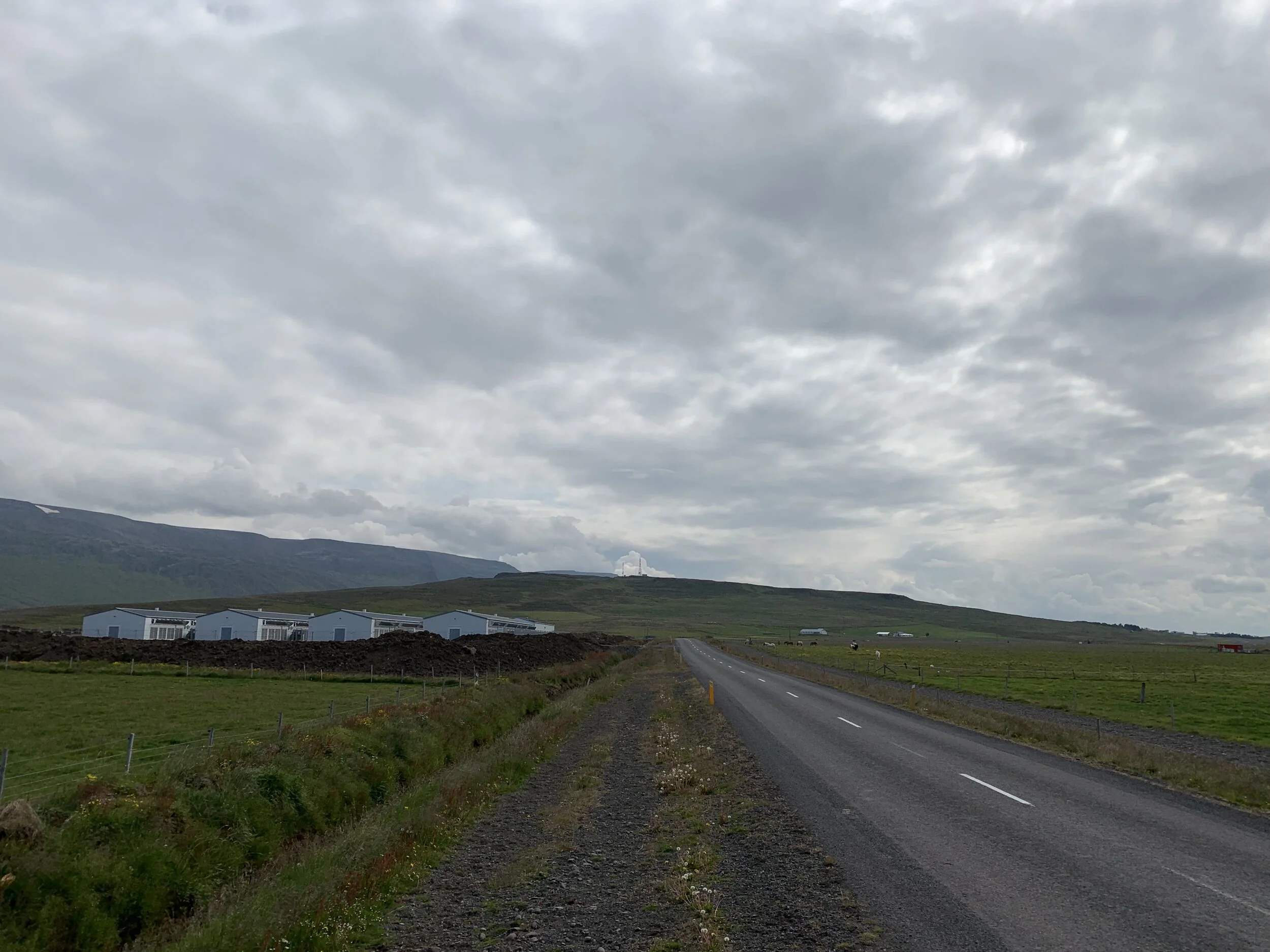Chasing the Cloud: Introduction to Network Infrastructure
Instructor: Zane Cooper
Email: zane.cooper@asc.upenn.edu
Assignments:
Infrastructure is never really invisible. We just are not trained to notice it properly. This class is intended to help develop the art of noticing, of seeing, of thinking through the infrastructural connections that undergird our lives. The project for this course is an iterative one that you will complete as a group throughout our time together.
Your homework, before each session, is to go on a “data walk”, in which you will begin training yourself to notice how network infrastructure operates in your neighborhood. On these data walks, you will become a network archaeologist, discovering traces of connections you have never noticed before. Use each session as a primer for what to look for. You will take pictures of your findings and upload them to an Instagram account I have created especially for this course. In addition to posting picture(s), you will write 200-300-word blog posts about each walk (what you noticed, how you felt, the weather, how it smelled, the textures you encountered, etc.), and paste them in the comments of your Instagram post. At the end of the course, you all will have built a collective collage of network infrastructure from all over the country and world! At least that is the hope, right?
Let’s get noticing! Use Ingrid Burrington’s field guide below to get ideas for how to start noticing the infrastructure all around you!
Session 1: What is Infrastructure?
We will spend our first session collectively unpacking what infrastructure is, how it is used to pursue and embed ideological objectives, and how the Internet has been shaped by those objectives.
READINGS:
Session 2: Path Dependencies
Today we will look at the infrastructural history of communication in the United States, and how the paths taken by these older systems have been incorporated into the material shape of the Internet.
READINGS
Session 3: Cables
Today we delve into the dirty business of “connection” – what it takes, how it happens, and who makes it happen. We will explore interactive submarine cable maps and screen an excerpt of Rithy Panh’s documentary about connecting Cambodia called The Land of Wandering Souls (1999)
READINGS:
In-Class Screenings
We will watch sections of these together in class, but I am posting them so that you can watch the rest, if you’re interested.
Buried, Bundled, and Behind Closed Doors (2010, Dir. Ben Mendelsohn)
The Land of Wandering Souls (2000, Dir. Rithy Panh)
The Land of Wandering Souls (2000, Dir. Rithy Panh)
Session 4: Data Centers
Today we will discuss the social and environmental implications of data centers and the various infrastructural relationships required to keep them humming.
READINGS
Cryptocurrency mining data center in Blönduós, Iceland (Photo by me)
Session 5: Imagining the Cloud
Today we will look at how “the cloud” is branded, and the ways in which this branding masks the infrastructural complexity of the internet.
The first image that appears when you search for “The Cloud” on Google
Session 6: Network Infrastructures Elsewhere and Otherwise
Today we will explore the multiplicity of material manifestations of the internet across the globe, with a focus on Africa, and how access and reliability of other infrastructural systems shape internet access and use. We will see how one’s material relationship to network infrastructure is political, and shaped by race, class, and colonial histories.
READINGS:
Session 7: The Stuff of Blockchain
Today we will be discussing cryptocurrency and blockchain, but from an infrastructural perspective. What seems like an immaterial, decentralized network soon becomes far heavier and more complex the closer we look.
READINGS:
A Bitmain Antminer S7 in a liquid immersion cooling tank.
Session 8: Mining Data
Today we talk explicitly about dirty data, and how we cannot understand digital networks without understanding how dirt and rocks get extracted, moved, and formed into information. In our discussion, we will unpack how digital data, and the infrastructure that supports it, depend on raw resource mining around the globe.
A rare earth mine tailings pond in the Baotou region of Inner Mongolia, China
Session 9: Maintenance/Care/Waste
Today we talk about the complex problem of E-waste, and try to come to terms with what waste is in the first place – how it is defined, and the politics of those definitions. What exactly is “waste” and how do we care for it?
Further Reading
What follows is a long, but far from comprehensive list of notable sources on the topics we covered in class. This is a deep, expansive list, with much to explore. Get reading!
Appadurai, A. (Ed.). (1986). The Social Life of Things: Commodities in cultural perspective. Cambridge University Press.
Boyer, D. (2014). Energopower: An Introduction. Anthropological Quarterly, 87(2), 309–334.
Boyer, D. (2018). Infrastructure, Potential Energy, Revolution. In The Promise of Infrastructure (pp. 223–243). Duke University Press.
Brunton, F. (2013). Spam: A Shadow History of the Internet. MIT Press.
Brunton, F. (2019). Digital cash: The unknown history of the anarchists, utopians, and technologists who created cryptocurrency. Princeton University Press.
Chun, W. H. K. (2006). Control and Freedom: Power and Paranoia in the Age of Fiber Optics. MIT Press.
Chun, W. H. K. (2011). Programmed Visions: Software and Memory. MIT Press.
Chun, W. H. K. (2016). Updating to remain the same: Habitual new media. MIT Press.
Cowen, D. (2014). The Deadly Life of Logistics: Mapping Violence in Global Trade. University of Minnesota Press.
Crawford, K., & Joler, V. (n.d.). Anatomy of an AI System. Anatomy of an AI System. Retrieved January 1, 2020, from http://www.anatomyof.ai
Cubitt, S. (2017). Finite Media: Environmental Implications of Digital Technologies. Duke University Press.
Ensmenger, N. (2018). The Environmental History of Computing. Technology and Culture, 59(4S), S7–S33. https://doi.org/10.1353/tech.2018.0148
Gitelman, L. (Ed.). (2013). “Raw data” is an oxymoron. The MIT Press.
Grappi, G., & Neilson, B. (2019). Elements of logistics: Along the line of copper. Environment and Planning D: Society and Space, 37(5), 833–849. https://doi.org/10.1177/0263775818814535
Halpern, O. (2014). Beautiful Data: A History of Vision and Reason since 1945. Duke University Press.
Haraway, D. (2012). A manifesto for cyborgs: Science, technology, and socialist feminism in the 1980s. In Coming to Term: Feminism, Theory, Politics (pp. 173–204). https://doi.org/10.4324/9780203093917
Haraway, D. (2015). Simians, Cyborgs, and Women: The Reinvention of Nature. Routledge.
Harney, S., & Moten, F. (2013). The undercommons: Fugitive planning & black study. Minor Compositions.
Hecht, G. (2011). Entangled geographies: Empire and technopolitics in the global Cold War. MIT Press. https://doi.org/10.1126/science.1247727
Hecht, G. (2014). Being Nuclear: Afrians and the Global Uranium Trade. MIT Press.
Hockenberry, M. (2018). Material Epistemologies of the (Mobile) Telephone. Anthropological Quarterly, 91(2).
Hogan, M. (2015). Facebook Data Storage Centers as the archive’s underbelly. Television and New Media, 16(1), 3–18. https://doi.org/10.1177/1527476413509415
Hogan, M. (2018). Data is airborne; Data is inborn: The labor of the body in tecnologies. First Monday, 23(3). https://doi.org/10.5210/fm.v23i3.8285
Horowitz, L. S., Keeling, A., Lévesque, F., Rodon, T., Schott, S., & Thériault, S. (2018). Indigenous peoples’ relationships to large-scale mining in post/colonial contexts: Toward multidisciplinary comparative perspectives. The Extractive Industries and Society, 5(3), 404–414. https://doi.org/10.1016/j.exis.2018.05.004
Hughes, T. P. (1983). Networks of Power: Electrification in Western Society, 1880-1930. Johns Hopkins University Press.
Jackson, S. J. (2014). Rethinking Repair. In T. Gillespie, P. Boczkowski, & K. Foot (Eds.), Media Technologies: Essays on Communication, Materiality and Society. MIT Press.
Jasanoff, S., & Kim, S.-H. (Eds.). (2015). Dreamscapes of Modernity: Sociotechnical Imaginaries and the Fabrication of Power. University of Chicago Press. https://doi.org/10.7208/chicago/9780226276663.001.0001
Johnson, A. (2019). Data centers as infrastructural in-betweens: Expanding connections and enduring marginalities in Iceland. American Ethnologist. https://doi.org/10.1111/amet.12735
Kitchin, R., & Lauriault, T. P. (2014). Towards critical data studies: Charting and unpacking data assemblages and their work. 19.
Kline, R. R. (2015). The cybernetics moment: Or why we call our age the information age. Johns Hopkins University Press.
Klinger, J. M. (2017). Rare Earth Frontiers: From Terrestrial Subsoils to Lunar Landscapes. Cornell University Press.
Klose, A. (2015). The Container Principle: How a Box Changes the Way We Think. MIT Press.
Lally, N., Kay, K., & Thatcher, J. (2019). Computational parasites and hydropower: A political ecology of Bitcoin mining on the Columbia River. Environment and Planning E: Nature and Space, 251484861986760. https://doi.org/10.1177/2514848619867608
Larkin, B. (2013). The politics and poetics of infrastructure. Annual Review of Anthropology, 42, 327–343.
Lepawsky, J. (2018). Reassembling Rubbish: Worlding Electronic Waste. MIT Press.
Magaki, I., Khazraee, M., Gutierrez, L. V., & Taylor, M. B. (2016). ASIC Clouds: Specializing the Datacenter. 2016 ACM/IEEE 43rd Annual International Symposium on Computer Architecture (ISCA), 178–190. https://doi.org/10.1109/ISCA.2016.25
Malm, A. (2016). Fossil Capital: The Rise of Steam Power and the Roots of Global Warming. Verso.
Mattern, S. (2016a). Of Mud, Media, and the Metropolis. Cultural Politics an International Journal, 12(3), 310–331. https://doi.org/10.1215/17432197-3648870
Mattern, S. (2016b, August). Cloud and Field. https://doi.org/10.22269/160802
Mattern, S. (2017). Code + Clay...Data + Dirt. University of Minnesota Press.
Mavhunga, C. (2017). What Do Science, Technology, and Innovation Mean From Africa. MIT Press.
Maxwell, R., & Miller, T. (2012). Greening the Media. Oxford University Press.
Mezzadra, S., & Neilson, B. (2019). The Politics of Operations. Duke University Press.
Nicholas, G. (2019). The Crypto Family Farm. Logic Magazine. https://logicmag.io/bodies/the-crypto-family-farm/
Parikka, J. (2016). A Geology of Media. University of Minnesota Press.
Parks, L. (2015). Stuff You Can Kick: Toward a Theory of Media Infrastructures. In P. Svensson & D. T. Goldberg (Eds.), Between Humanities and the Digital (pp. 355–373). MIT Press.
Parks, L., & Starosielski, N. (2015). Signal Traffic: Critical Studies of Media Infrastructures. University of Illinois Press.
Peters, J. D. (2015). The Marvelous Clouds: Toward a Philosophy of Elemental Media. University of Chicago Press.
Prieto-Ñañez, F. (2016). Postcolonial Histories of Computing. IEEE Annals of the History of Computing, 38(2), 2–4. https://doi.org/10.1109/MAHC.2016.21
Quijano, A. (2000). Coloniality of power, eurocentrism, and Latin America. Nepantla: Views from South, 1(3), 533–580.
Rossitter, N. (2016). Software, infrastructure, labor: A media theory of logistical nightmares. Routledge.
Sheller, M. (2014). Aluminum Dreams: The Making of Light Modernity. MIT Press.
Sheller, M. (2018). Mobility Justice: The Politics of Movement in an Age of Extremes. Verso.
Starosielski, N. (2016). Thermocultures of Geological Media. Cultural Politics an International Journal, 12(3), 293–309. https://doi.org/10.1215/17432197-3648858
Starosielski, N., & Walker, J. (Eds.). (2016). Sustainable Media: Critical Approaches to Media and Environment. Routledge.
Strebel, I., Bovet, A., & Sormani, P. (Eds.). (2019). Repair Work Ethnographies: Revisiting Breakdown, Relocating Materiality. Springer Singapore. https://doi.org/10.1007/978-981-13-2110-8
Tsing, A. (2009). Supply Chains and the Human Condition. Rethinking Marxism, 21(2), 148–176. https://doi.org/10.1080/08935690902743088
Tsing, A. L. (2005). Friction: An Ethnography of Global Connection. Princeton University Press.
Tsing, A. L. (2012). On Nonscalability: The Living World Is Not Amenable to Precision-Nested Scales. Common Knowledge, 18(3), 505–524.
Tsing, A. L. (2015). The Mushroom at the End of the World. Princeton University Press.
Vonderau, A. (2018). Scaling the Cloud: Making State and Infrastructure in Sweden. Ethnos., 1,21.
Watts, M. J. (2019). Reflections on circulation, logistics, and the frontiers of capitalist supply chains. Environment and Planning D: Society and Space, 37(5), 942–949. https://doi.org/10.1177/0263775819869446
Williams, R. (2008). Notes on the Underground: An Essay on Technology, Society, and the Imagination. MIT Press.
Winner, L. (1986). The Whale and the Reactor: A Search for Limits in an Age of High Technology. University of Chicago Press.
Yusoff, K. (n.d.). Queer Coal: Genealogies in/of the Blood. 28.
Yusoff, K. (2018). A Billion Black Anthropocenes or None. University of Minnesota Press.
Zook, M. A., & Blankenship, J. (2018). New spaces of disruption? The failures of Bitcoin and the rhetorical power of algorithmic governance. Geoforum, 96, 248–255. https://doi.org/10.1016/j.geoforum.2018.08.023








